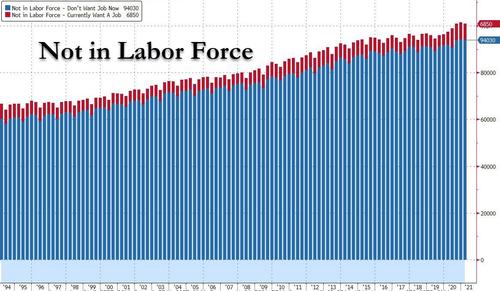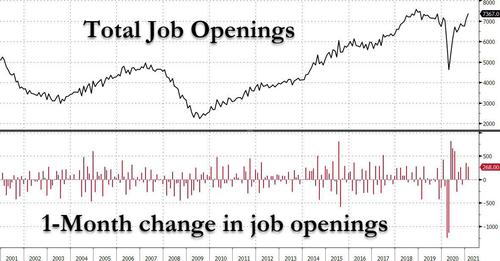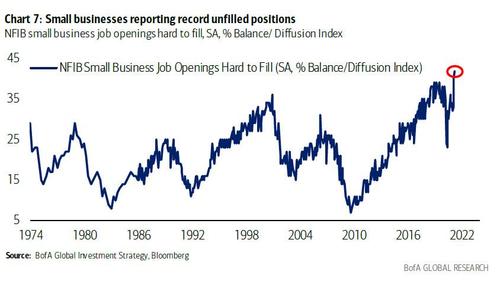"There Are Absolutely No Job Seekers": How Trillions In Stimulus Sparked A Historic Job Market Crisis
Something odd is going on in the US economy.
On one hand, in the aftermath of the covid pandemic, there are millions and millions of former workers who have lost their jobs and are unable to return as their job may not even exist today (while their skills atrophy and they become increasingly unemployable with every day they are unemployed). Addressing this, on Thursday Fed Chair Powell spoke at an IMF panel saying that over nine million Americans remains out of work, while a quick look at the latest BLS data shows that there are over 100 million Americans who are out of the labor force (of whom just 6.85MM want a job currently, and a record 94 million don't want a job).
(Click on image to enlarge)

At the same time, as we pointed out last night, JPMorgan and many others have noted that when one looks at the recent JOLTS data, which showed a near-record number of job openings, a clear trend is emerging: there is a big labor shortage in the US, one which could (finally) lead to higher wages in the US.
(Click on image to enlarge)

While JPMorgan did not dwell on what may be causing this unprecedented schism within the economy - after all, for normalcy to return, people must not only be employed but must want to be employed - it did suggest that the "robust" government stimulus may be keeping workers on the sidelines, a more detailed analysis from Bloomberg confirms the nightmare scenario: the trillions in Biden stimulus are now incentivizing potential workers not to seek gainful employment, but to sit back and collect the next stimmy check for doing absolutely nothing in what is becoming the world's greatest "under the radar" experiment in Universal Basic Income.
Consider the following striking anecdotes:
- Early in the Covid-19 pandemic, Melissa Anderson laid off all three full-time employees of her jewelry-making company, Silver Chest Creations in Burkesville, Ky. She tried to rehire one of them in September and another in January as business recovered, but they refused to come back, she says. “They’re not looking for work.”
- Sierra Pacific Industries, which manufactures doors, windows, and millwork, is so desperate to fill openings that it’s offering hiring bonuses of up to $1,500 at its factories in California, Washington, and Wisconsin. In rural Northern California, the Red Bluff Job Training Center is trying to lure young people with extra-large pizzas in the hope that some who stop by can be persuaded to fill out a job application. “We’re trying to get inside their head and help them find employment. Businesses would be so eager to train them,” says Kathy Garcia, the business services and marketing manager. “There are absolutely no job seekers."
These are not one-off cases: these real-life events, revealed by Bloomberg, expose the striking statistical reality in the US: on April 1 the NFIB (National Federation of Independent Business) reported that in March a record-high percentage of small businesses surveyed said they had jobs they couldn’t fill: 42%, vs. an average since 1974 of 22%.
(Click on image to enlarge)

Even more amazing: a stunning 91% of respondents said they had few or no qualified applicants for job openings in the past three months, tied for the third-highest since that question was added to the NFIB survey in 1993.
One of our favorite labor market metrics, the so-called "take this job and shove it" indicator- or the "Quits" rate from the JOLTS survey - is the latest confirmation of how empowered workers feel: in March the number of people quitting jobs hit 2.3% of overall employment in January, just a tenth of a percentage point below the record going back to 2001.
But what is most striking is the context on these figures: recall that just one year ago, the unemployment rate was a depression-era 14.8%. And while it has since dropped to 6%, it remains well above the 3.5% rate of February 2020, before the pandemic. So judging from the jobless rate - which the Federal Reserve tracks closely - there’s still plenty of slack in the labor market.
But that’s not how employers and job counselors see it. There will be even less slack in the coming months as the economy strengthens. The median forecast of economists surveyed by Bloomberg is that the jobless rate will fall to 4.5% in the second quarter of 2022.
* * *
What's behind this unprecedented revulsion to work - which paradoxically comes at a time when the Fed still sees record slack in the economy as the primary reason behind avoiding tightening financial conditions for years to come?
To be sure, Covid is part of the problem. Fear of it the disease has kept some would-be workers home, especially in customer-facing businesses. And with schools closed by Covid, some parents are turning down work to care for children, says Holly Wade, executive director of the NFIB Research Center. Also, she says, the small businesses in the NFIB survey may have trouble competing for workers with the likes of Amazon.com, whose worldwide employment grew 63% last year, to 1.3 million. But fear of covid is irrelevant if one has no money and must put food on the table. When the alternative is starvation, one will do anything - even brave the Wu-Flu.
But the real reason behind America's sudden distaste to step away from one's computer, go out and look for a job, is that it is already getting a weekly stimmy from the Biden admin, which has pivoted the pandemic emergency into a platform for what is rapidly becoming an unprecedented experiment in Universal Basic Income.
As Bloomberg writes, it is becoming increasingly the case that "generous unemployment benefits discourage people from seeking work." Anderson, the jewelry maker, says her ex-employees told her they preferred to stay unemployed—even though you’re not supposed to collect jobless benefits if you’re turning down work. But it's not like anyone will check.
The American Rescue Plan that Congress approved last month provides an extra $300 a week in jobless benefits through Sept. 6. "There still will be some people who say, ‘I’m glad to take my $300 to $400 a week and stay home, rather than go out and work and earn $500 a week,’” BTIG LLC analyst Peter Saleh, who covers the restaurant industry, told Bloomberg in March.
Others are convinced that they will never get hired, so they don't even try: as Bloomberg notes, some would-be workers may have lost their gumption. “I’m worried that after all this time that’s gone by, it’s going to be very hard for a lot of people to come back full time. It’s just asking an energy level that people haven’t had in a while,” says Garcia, the job counselor in California. She says a full-time job “used to be the gold standard,” but now employers are parceling out the work into part-time jobs to lure applicants."
And that's why there are now 100+ million people not in the labor force.
Of course, while liberals could have never possibly imagined such an outcome, conservatives were warning from day one that if you hand out free money, the desire to work will vaporize and that's precisely what we have seen. But while one can point to the disintegration in the US labor market as a way to "own the libs", the transformation in the job market is far more serious and is about to become a full-blown crisis because it is now keeping an entire generation away from the workforce - the most important generation.
According to Bloomberg, alienation from work is most common among the young. A Pew Research Center survey in October found that 53% of those ages 18 to 29 who are working remotely because of Covid said it was difficult for them to feel motivated to perform their duties. Only 20% of those 50 and older said the same.
On the social network Reddit, which skews young, a forum called r/antiwork has 264,000 members. It’s filled with comments such as: “You’re telling me I have to enslave myself to all these applications for hours on end, competing with my fellow man and woman, giving up my dignity just for a chance to enslave myself further so I don’t literally die? I’m not having it.” One Redditor posted a video of a home computer’s mouse that’s connected to a swiveling fan so it slides back and forth, making it appear the person is working.
To be sure, there is a "chicken or egg" component (with a solid dollop of socialism thrown in for good measure): since many of the jobs that employers can’t fill are low-paying, there are few spoiled GenZ and Millennial applicants for entry-level pay (they would much rather collect 6 figures off the bat), while the high-paying ones generally require skills... skills that most young Americans don’t have simply because they refuse to "subject" themselves to entry-level jobs that will build up the skills they need to be better paid.
And so, a historic crisis emerges, one where the government is actively subsidizing the minimum-wage sedentary snowflake lifestyle (while indoctrinating the young generation in liberal propaganda), which prevents those same workers from getting real jobs and developing real skills they will need to make real money.
In short, a toxic feedback loop created by the government which - in its hope of becoming ever bigger - it has no intention of ever breaking. Meanwhile, an entire lost generation of workers is emerging.
There is, of course, one way to short-circuit this feedback loop - much higher wages, which is precisely what the Fed is hoping will be the outcome. As Bloomberg observes, "employers would have an easier time filling job openings if they raised pay or got less picky about qualifications."
Re’gine Johnson, 26, of Chicago said she interviewed with 40 companies before she landed a job, even after completing a three-month General Assembly boot camp in user interface design. “They’re thinking, ‘Do we really want to invest in somebody that’s so junior, do we have the time to teach them something they may not know?’” she says. She’s thriving now at Neon One LLC, the software company that hired her and provided on-the-job training.
Most others won't have the patience that Neon One demonstrated. And for those hoping that employers will hike wages to attract entry-level talent, we have a question - they didn't do it for the past decade, why will they do it now. Well, this is where the government comes in again, with its mandatory minimum wage hikes, which however end up killing far more jobs than they create as most small and medium businesses simply don't have the margin capacity to hike base pay by 10%, 20% or more and keep operating as is. Instead, they have no choice but to lay other workers off, leading to a net increase in unemployment.
In any case, now that Universal Basic Income courtesy of Helicopter Money is the sad new reality, employers will have no choice but to adjust to a world in which workers are harder to get. In Cleveland, manufacturers are striving to change the outdated impression that their jobs are dirty, boring, or dangerous because recruitment shortfalls are forcing them to turn away orders, says Ethan Karp, president, and CEO of Magnet, a nonprofit consultancy. “It’s their No. 1 problem,” he says.
And so, once again, we have a vivid demonstration of how anything the government touches - or subsidizes - escalates to a full-blown crisis, or simply turns to shit...
Disclaimer: Copyright ©2009-2021 ZeroHedge.com/ABC Media, LTD; All Rights Reserved. Zero Hedge is intended for Mature Audiences. Familiarize yourself with our legal and use policies every time ...
more


